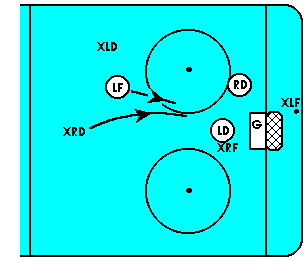Penalty Killing Strategy -- by Greg Siller
The objective of any penalty killing unit is to play the percentages and stop the
opposing team from scoring. A team does this by using quickness, discipline, and an
overall penalty killing strategy. The coach must ensure that the penalty killing unit
understands and executes the following three penalty killing fundamentals:
- Control the area around the slot. There are at least two ways of doing this. The
first way is to physically position a penalty killing player in the slot to control that
area; preventing attackers from screening your goaltender, deflecting a puck into the net,
or receiving a pass or a rebound. The second, and probably more effective way, is to
position the penalty killing players around the perimeter of the slot to control that area
using a triangular formation for roller hockey (see figure) or a box for ice hockey. The
penalty killing team plays a series of two-on-ones between the puck carrier and the
supporting players; attempting to break up a pass and gain control of the puck. If a pass
does get to the slot, one defender should immediately converge on the attacker to gain
control of the puck and to prevent any rebounds.
- Coordinate with your goaltender. Involving your goaltender in each penalty
killing situation neutralizes some of your manpower disadvantage. Communication between
the penalty killing unit and the goaltender is essential so there is no confusion about
loose pucks or possible rebounds.
- Work the clock. When playing a running time game, get as many face-offs as you
can. You'll tick off five-to-ten seconds for every face-off. Make player changes when the
play is stopped but the clock is ticking. Although the referee may object to too many
player changes, take advantage of at least one or two per penalty. Every player change
reduces the remaining penalty time by at least five seconds.
One-player short. The most efficient way to play this situation is by using a
triangular formation for roller hockey (the circled players shown in the figure) or a box
formation for ice hockey. For the triangular formation (roller hockey), have two penalty
killers play low to cover the deep attackers and the remaining penalty killer plays high
to cover the opponents point men. For the box formation (ice hockey), have the four
players surround the slot; with two players down low and two near the defensemen.
 When the attacker XLD has
control of the puck high in the offensive zone, LD and RD play-the-pass between the deep
attackers while LF plays-the-pass between the remaining attackers.
When the attacker XLD has
control of the puck high in the offensive zone, LD and RD play-the-pass between the deep
attackers while LF plays-the-pass between the remaining attackers.
If the puck is moved behind the net (see figure), do not go behind the net because
the majority of time you will lose that battle to the opponents out front! When the puck
is moved behind the net, play the percentages and force the puck carrier to make the first
move. Generally in this situation, one of the attacking defensemen will move in toward the
slot for a shot. LF should constantly read the positioning of the attacking point men as
well as the puck carrier behind the net. He should move to the slot along with either
rushing defenseman and communicate with his teammates along the way.
When you gain control of the puck, freeze it, skate with it, or shoot it down the playing
surface. Either way, you knock precious time off the clock.
Two-players short. The objective in this situation is to let your goaltender
play-the-shooter while the penalty killers make sure that passes across the slot and
rebounds are controlled. Get as many stoppages of play as possible to try and eat away at
the clock. If you come away without a goal being scored on you, you've done a fine job.
Give your players plenty of practice in penalty killing situations so that they can
experience the best tactics to use. Hockey is not a very forgiving sport for penalty
killing teams that do not practice.
 When the attacker XLD has
control of the puck high in the offensive zone, LD and RD play-the-pass between the deep
attackers while LF plays-the-pass between the remaining attackers.
When the attacker XLD has
control of the puck high in the offensive zone, LD and RD play-the-pass between the deep
attackers while LF plays-the-pass between the remaining attackers.